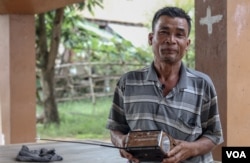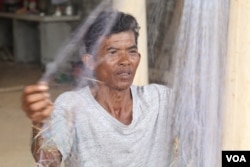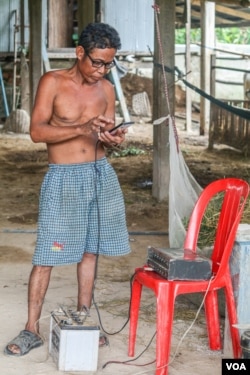
RADIO SILENCE: PART ONE
STORY BY SUN NARIN & KHAN SOKUMMONO
EDIT BY ANANTH BALIGA
Editor's Note: Two years after the government’s harshest crackdown on the free press, VOA Khmer looks at how Cambodians are keeping themselves informed in a country deprived of independent and critical news coverage. A series of government-initiated actions changed the Cambodian media landscape, affecting people’s news consumption and potentially leaving many of them in the dark.
The silencing of radio waves had the biggest impact, especially in rural Cambodia. Radio news broadcasts were a staple for rural Cambodians, who until recently had little access to affordable smartphones, phone data packages and independent newspapers.
In the first story of this three-part series, VOA Khmer reporters travelled to southeastern Cambodia to visit a village in Prey Veng province, where rural Cambodians are dealing with an unusual predicament – stay away from the news and remain safe or listen to critical news broadcasts and risk being labelled an opposition supporter.
PREY VENG PROVINCE, Cambodia — Yort Kean has a fine-tuned appetite for the news. The rice farmer is constantly on the lookout for snippets of news or is listening in on hushed discussions about the current political situation in Cambodia. But his want for independent news coverage is far from satiated.
In Prey Veng province’s Sithor Kandal district, like in many parts of the country, villagers are careful with their news consumption habits. Listening to news broadcasts considered incendiary by the ruling Cambodian People’s Party (CPP) can make life difficult in the small village of Char, villagers say.
For the self-professed radio news junkie, a small coffee shop in the village provides some refuge. Here he can chat with friendly villagers about political news, although always on the lookout for neighbors affiliated with the ruling party.
“But if people that we don’t know come, we dare not to talk [about the news] and we talk about some other things,” Yort Kean said.
Yort Kean finds himself in these circumstances because of a severe government crackdown on independent news outlets in 2017, significantly changing Cambodia’s media landscape. The unprecedented crackdown – the first this severe since the 1993 UNTAC elections -- also targeted the political opposition and civil society organizations, using a concocted “color revolution” narrative.
The largest impact was felt when the government shutdown more than two dozen mostly small and local radio stations and frequencies for alleged administrative violations. Incidentally, all were broadcasting Khmer-language news programming from Radio Free Asia (RFA), Voice of Democracy (VOD) and Voice of America (VOA).
Even if we listen to the news, we do it secretly or with the volume down. We don’t dare to make it loud.”
Not only were these radio broadcasters effectively denied access to rural listeners – who rarely were able to buy and read independent newspapers and relied on their transistor radios to get the news, rather than smartphones connected to the internet – but they were also incorporated into the alleged color revolution plot as “pro-opposition” organizations.
This last move, in effect, made the act of listening to the Khmer-language broadcasts from RFA, VOD and VOA objectionable by the ruling party and its supporters.
Hence, the hushed discussions around Yort Kean’s village.
Secretly tuning in
August marked two years since some two dozen radio frequencies were closed down, with only a few later returning to the airwaves, but none resumed transmission of RFA, VOD and VOA programming for Cambodians. Some of these broadcasters continued or shifted to AM transmissions and Facebook broadcasts, though with not the same reach FM programming afforded them.
Yort Kean fondly remembers the easy access to independent news broadcasts his three-band radio gave him; airwaves that are now choked with pro-government or propagandist news reports.
“In the beginning, after seven days [of not listening], I could not sleep since I could not listen to the news,” he recently told VOA Khmer at his home.
“Even if we listen to the news, we do it secretly or with the volume down. We don’t dare to make it loud,” Yort Kean said.
He said he is aware that giving an interview to VOA Khmer makes him a potential target and local authorities would likely question him later. Yort Kean’s apprehensions are not unfounded.
Following the arrest of Cambodia National Rescue Party (CNRP) leader Kem Sokha in September 2017, the Supreme Court ruled to dissolve the opposition party, outlawing 118 senior members from any political activity, delivering a chilling effect throughout the country to grassroots activists and supporters of the opposition.
Though they don’t allow me to listen in the public, but I still listen at my home. Those radio broadcasts report the truth.”
The government this year effectively has extended this political-activity ban to former, low-ranking CNRP commune and district officials. In April and May, at least 140 former members of the party were summoned by a court or questioned at local police offices for alleged activity linked to the CNRP.
The allegations amounted to expressing dissenting opinions or participating in group discussions about politically sensitive issues.
Several villagers who VOA Khmer reporters talked to said they were wary of expressing their opinions. They all expressed the sense of being isolated from the rest of the country.
Nguon Hul, another farmer in the same village, initially told reporters that he did not listen radio news broadcasts, but then explained he listened to news broadcasts on a smartphone.
The reason for Nguon Hul’s initial hesitancy became clear after he explained his affiliation with the CNRP, as a grassroots activist. The rice farmer said he bought a smartphone connected to the internet so that he can watch videos and listen to audio clips online.
But, as with Yort Kean, he said he needs to tune-in secretly. Nguon Hul is aware he can get in trouble for listening to these news reports. Yet he has become the village’s de facto news anchor, discreetly sharing news he heard on his smartphone with other villagers.
“Though they don’t allow me to listen in the public, but I still listen at my home,” Nguon Hul said. “Those radio broadcasts report the truth.”
I don’t listen since they mostly attack our work,” said Hou Nhip, his two iPhones lying beside him. “There is little truth [from those radio stories] but a lot of falsehoods.”
Critiques versus attacks
Opinions over news content are stark and polarizing in the commune. There are villagers who consider critical news reports to be truthful about government’s actions, whereas those affiliated with the ruling party find them inflammatory.
This is evident in ruling party commune chief Hou Nhip’s outlook on radio broadcasts. He is quick to deny the villagers’ allegations, adding they can listen to any news programming.
Still, in the next breath, he asserted broadcasters like RFA and VOA present the news as an “attack” on the government rather than a fair “criticism” of their policies.
“I don’t listen since they mostly attack our work,” said Hou Nhip, his two iPhones lying beside him. “There is little truth [from those radio stories] but a lot of falsehoods.”
Hou Nhip’s assurances have little resonance in the commune. Khun Kheab, who is a farmer and runs a catering business, is aware of the downside to listening to RFA and VOA broadcasts. Unlike some of his neighbors, though, he is trying to push the limits.
I am playing it louder so that villagers who don’t have radios and smartphones can hear the news.”
Undeterred by the ramifications of listening to news reports from certain broadcasters, Khun Kheab has taken the responsibility to help others to access such news, and there is nothing clandestine about his methods.
Every day, you can hear news stories blaring from a $200 amplifier and speaker connected to his smartphone, and he is not shy with the volume control.
“I am playing it louder so that villagers who don’t have radios and smartphones can hear the news,” said the 57-year-old villager.
“They don’t need to come and ask me,’’ Khun Kheab said. ‘’They can hear it from their homes.”
Editor’s Note: In the second installment of ‘Radio Silence,’ VOA Khmer looks at how Cambodians are dealing with the transition away from radio broadcasts and the impacts of curtailed news access.
Read Radio Silence | Part Two
Read Radio Silence | Part Three








